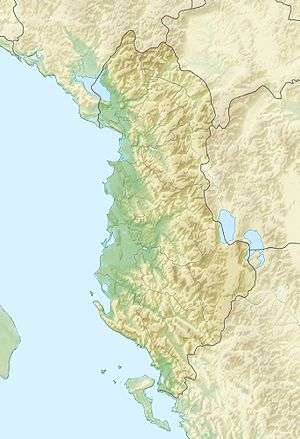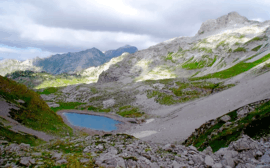Maja Jezercë
| Maja Jezercë | |
|---|---|
 Maja Jezercë as seen from Maja Trojan | |
| Highest point | |
| Elevation | 2,694 m (8,839 ft) [1] |
| Prominence | 2,036 m (6,680 ft) [2] |
| Listing | Ultra |
| Coordinates | 42°26′33″N 19°48′51″E / 42.44250°N 19.81417°ECoordinates: 42°26′33″N 19°48′51″E / 42.44250°N 19.81417°E [2] |
| Naming | |
| Translation | Lake Peak (Albanian) |
| Geography | |
 Maja Jezercë Albania | |
| Location | Shkodër County, Albania |
| Parent range | Albanian Alps (Prokletije), Dinaric Alps |
| Geology | |
| Mountain type | Limestone |
| Climbing | |
| First ascent | 1929 by Sleeman, Elmslie and Ellwood |
| Easiest route | North slope |
Maja Jezercë (Albanian: Maja Jezercë, Serbian: Језерски врх, Jezerski vrh), is the highest point of Prokletije and the entire Dinaric Alps, standing at 2,694 m (8,839 ft) AMSL.
Location and surroundings
The mountain peak in Albania, which is just five kilometres from the border with Montenegro, lies between the valleys of the Valbona to the east and the Shala in the west. In part, the whole floor between the valley of Shala, Valbona and Ropojana and Maja Roshit (2,522 metres) is known as Jezerca, in addition to the peak, Jezerca borders other peaks such as the Maja Popluks (2,569 metres) and the Maja e Ali (2,471 metres) in the west, the Maja Rrogamit (2,478 metres) to the east, Maja Kolajet (2,498 metres), Maja Malësores (2,490 metres) and Maja Bojës (2,461 metres) in the northwest and the Maja e Kokerhanës (2,508 metres ) and Maja Etheve (2,393 metres) in the north.
Apart from certain areas north of the Jezerca peak the mountain massif is part of the two National Parks of Thethi and Valbona.[3]
The summit can be climbed from the North without major equipment. Most climbers come from Gusinje in Montenegro or from Theth in the Shala valley.[4]
Topology and geography

Jezerca is a large rocky peak of dolomitic limestone. There is almost no vegetation there. North, east and west of the mountain top is in great cirque from that in the glacial periods when glaciers were more extensive than today. Today the northern cirque is called Buni i Jezercës at a height of 1980 metres and 2,100 metres in height around 400 metres. Because it is located in the wettest region of Europe with around 6 metres (240 in) of rainfall equivalent believed to fall on the western slopes, snowfall is so large that only in dry years do even the less exposed sections melt away.[5]
Name
The Albanian name, Maja Jezercë, is derived from the Slavic word, probably more specifically from Serbian jezero ("lake"), and Albanian word maja ("top" or "peak"), meaning "peak of Jezero". In Slavic, including Serbian[6] or more detail, Serbian[7][8][9] Jezerski Vrh means "lake peak". The toponym refers to the cirque lakes in the lower part of the Buni i Jezercës on the northern side of the mountain. During the Communist era in Albania it had been given the name of Maja e Rinisë (Mountain of Youth), which never stuck.[4]
First ascents
On 26 July 1929 British climbers Sleeman, Elmslie and Ellwood reached the summit of Maja Jezercë. Earlier that year, some Italian surveyors had climbed the Mountain and built a cairn.[10]
We got to the top at 8.45. Arrived there we found a recently built cairn – no doubt made by the Italian survey party we had been told about in Thethi.— Cyril Montague Sleeman, The Mountains of Albania
References
- ↑ "Maja e Jezercës". Peakbagger.com. Retrieved 2014-05-24.
- 1 2 "Europe Ultra-Prominences". Peaklist.org. Retrieved 2014-05-24.
- ↑ Florian Baba (Herausgeber): Linja e Gjelbër Shqiptare, Tirana 2008
- 1 2 "Summipost: Jezerca". Retrieved 2 August 2009.
- ↑ Milovan Milivojevića, Ljubomir Menkovića and Jelena Ćalić: Pleistocene glacial relief of the central part of Mt. Prokletije (Albanian Alps), in: Quaternary International, V. 190, 1, 1. November 2008, S. 112-122
- ↑ Elezi, Mehmet. "Kush i nemi "Bjeshkët e Nemuna"?". Gazeta55.
- ↑ Kolcakovski, Belj (1997). The periglacial zone of high mountains of Serbia and Macedonia and its basic characteristics. Observatoire de Montagne de Moussala.
- ↑ Vtora jugoslovenska onomasticka konferencij. Skopje: Makedonska akademija na naukite i umetnostite. 1980. Retrieved 11 September 2016.
- ↑ Petrović, Mihailo (1941). Đerdapski ribolovi u prošlosti i u sadašnjosti. Zadužbine Mikh. R. Radivojeviča. p. 8. Retrieved 11 September 2016.
- ↑ Sleeman, Cyril Montague (1930). "The Mountains of Albania". The Alpine Journal. Alpine Club. 42 (240): 55–69.